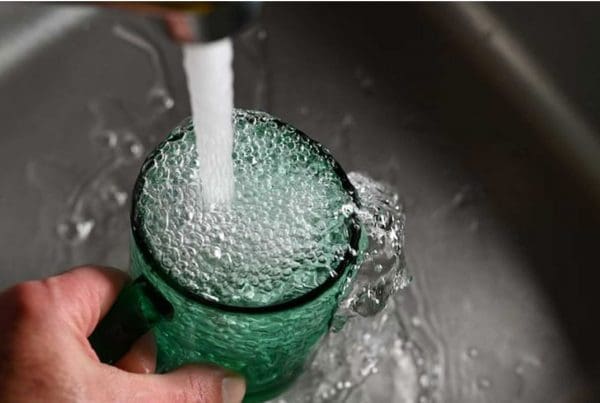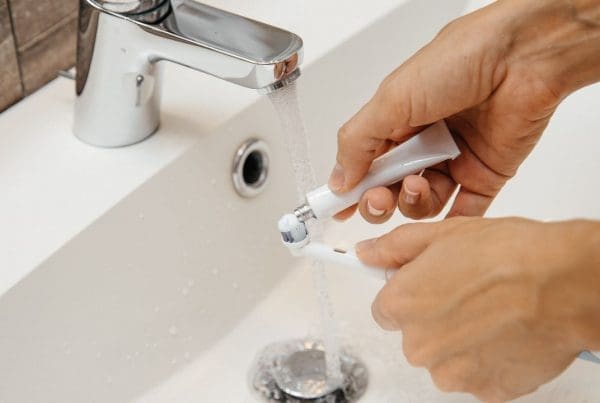Most stains on plumbing fixtures are of the dingy or yellow-brown variety. Just as common are the darker and more dramatic stains rust leaves behind. Most rust stains fall in the harmless category (resulting from high iron levels in the water supply, often from wells). Still, if your home has galvanized steel pipes, you should investigate further: the lines may be corroding, resulting in a leak. But have you ever had blue or green staining on fixtures? It happens! But why? And what can you do about it?
Copper is often found in well water, but it can be difficult to tell if your property has a rusty or contaminated private water well/supply. The first step is identifying what causes copper stains in water and testing for copper contamination. If you find that your private water supply does not meet health standards, there are several ways to remove the copper from your water supply so you can safely drink and cook with it again.
What causes copper stains in water?
Excessive corrosion leading to copper staining has two primary causes: acidic water or stray electrical current running through the plumbing system. The latter is rare but possible when an older home’s plumbing is incorrectly used as a ground for the home’s electrical system—or when DC from a mass transit power system finds its way there. Either case can result in an electrochemical process called electrolysis, accelerating metal corrosion—determining if electrolysis is behind copper leaks and staining can be difficult. Still, because it is uncommon, you can hold off calling the electrician until other possibilities have been ruled out. However, if you experience other electrical issues or get a shock touching pipes, that should be addressed immediately.

Copper stains in your water are usually caused by galvanic corrosion, and this occurs when two different metals are placed in contact, and one corrodes faster than the other. In this case, copper will be anodic to your copper pipes and fixtures, which will corrode away while they stay intact.
Blue or green staining occurs primarily with copper pipe and fittings (including brass, which is copper + zinc) and is caused by corrosion and dissolution of the metal. Water quality and electrical grounding hasten deterioration, adding excessive amounts of dissolved copper to the water from fixtures. When the copper-laden water is allowed to sit, it stains.
Acidic water (< 7pH) is the most common cause of copper staining. The dissolution of copper starts at about 6.8 pH and is further enhanced when the water supply is high in dissolved oxygen, carbon dioxide, or other gases. As the acidic water flows through the copper supply pipes, small amounts of metal are eaten away and dissolved into the water. Since we don’t usually dry off every water-using fixture after we’re done with it, the water sits and eventually stains the right surface. Unfortunately, most fixture surfaces are vulnerable.
How do I know if my private water well has copper?
If you have a private water supply, it’s important to know the potential contaminants in your water. High levels of copper can get into drinking water through either well water that has been contaminated or through corrosion of copper pipes. The main way copper pipes corrode is through acidic interaction, such as low pH levels in the water or if it’s buried in certain soils with high acidities.
Copper is not usually found in the groundwater that feeds your well, but it may enter your drinking water as it travels through your plumbing system. Copper is a metal that occurs naturally and is used to make many products, including parts for plumbing systems. Copper can get leach your drinking water as the water passes through your household plumbing system. Your body needs some copper to stay healthy, but too much is harmful. Copper is naturally present in well water and can be detected with professional water testing. Although copper is an essential trace element required to maintain good health, consumption of high levels of copper can cause nausea, vomiting, diarrhea, and headaches. 1.3 parts per million (or 1.3 mg/L) or less is considered a safe level of copper in drinking water, according to the Environmental Protection Agency (EPA). The EPA set 1.3 parts per million (ppm) as the Maximum Contaminant Level Goal for copper in water, which is a health-based goal and the level at which no known adverse effects on human health occur.
According to Harvard,
“Although copper is naturally found in water, excessive levels of copper in drinking water is usually caused by leaked copper from old, corroded household pipes and faucets. There is greater risk if water is stagnant from lack of use or using hot tap water (copper more easily dissolves at higher temperatures). In these cases, exposure to excess copper can be decreased by running cold tap water for several minutes before using. It is also advised to use only cold tap water for drinking and cooking, and to avoid drinking hot tap water.”
Copper staining has several possible causes—the best way to figure out what’s going on is to have the water professionally tested. Your staining problem may have no one particular reason, making it even more important to have a comprehensive overview of your water quality. Water treatment professionals can recommend the best solutions for your specific situation.
How do I prevent copper stains?
The best way to prevent copper stains is by maintaining proper plumbing maintenance habits: make sure you’re changing filters regularly (if applicable), checking for leaks, and replacing parts as needed. You should also check for signs of corrosion on all exposed metal surfaces throughout your home’s plumbing system every few months—it’s easy enough to do with a flashlight.
 In general, acidic water can be less so by installing an acid neutralizer. These devices use minerals to raise the water’s pH closer to neutral. For extremely acidic water (< 5.5 pH), water treatment professionals use a more advanced system to feed treatment chemicals into the supply directly. Acid neutralizers will make your water “harder,” but to what extent depends on many factors. Should the newly-hard water start to affect fixtures or skin/hair, you might also need to invest in a water softener.
In general, acidic water can be less so by installing an acid neutralizer. These devices use minerals to raise the water’s pH closer to neutral. For extremely acidic water (< 5.5 pH), water treatment professionals use a more advanced system to feed treatment chemicals into the supply directly. Acid neutralizers will make your water “harder,” but to what extent depends on many factors. Should the newly-hard water start to affect fixtures or skin/hair, you might also need to invest in a water softener.
A reverse osmosis system is a great option to remove contaminants from your water, including copper compounds. Reverse Osmosis is a filtration system designed to remove dissolved solids, organic and inorganic forms, that a water softener cannot. RO removes metals like arsenic, aluminum, copper, lead, chromium, etc. It also removes inorganic forms such as nitrates, phosphates, chlorides, and sulfates. RO forces water from your home’s supply through the RO membrane. This membrane contains thousands of tiny holes, just large enough to allow water molecules to pass through. Anything bigger than a water molecule is trapped and cannot fit through the membrane. C and J Water offers a premium 4-stage Reverse Osmosis System that is a great solution for water used for drinking and cooking.
If you don’t want to spend money on these systems but still want to eliminate your copper staining problem in the kitchen sink or bathroom faucet(s), try using granular activated carbon filters on either tap instead of buying an entirely new unit altogether. These filters will help reduce any existing discoloration without having to install anything else inside your home’s plumbing system; however, remember that these types will not permanently solve this issue because, eventually, they’ll need replacement too.
Removing copper from your water supply is easy with the right treatment system.
Ultimately, this article has helped you understand what causes copper stains in water and how to remove them. If you have any questions or concerns about your property’s water supply, please don’t hesitate to reach out! We would be happy to help answer any questions or concerns regarding our treatment systems—just call us at 317-733-SOFT or contact us online!




